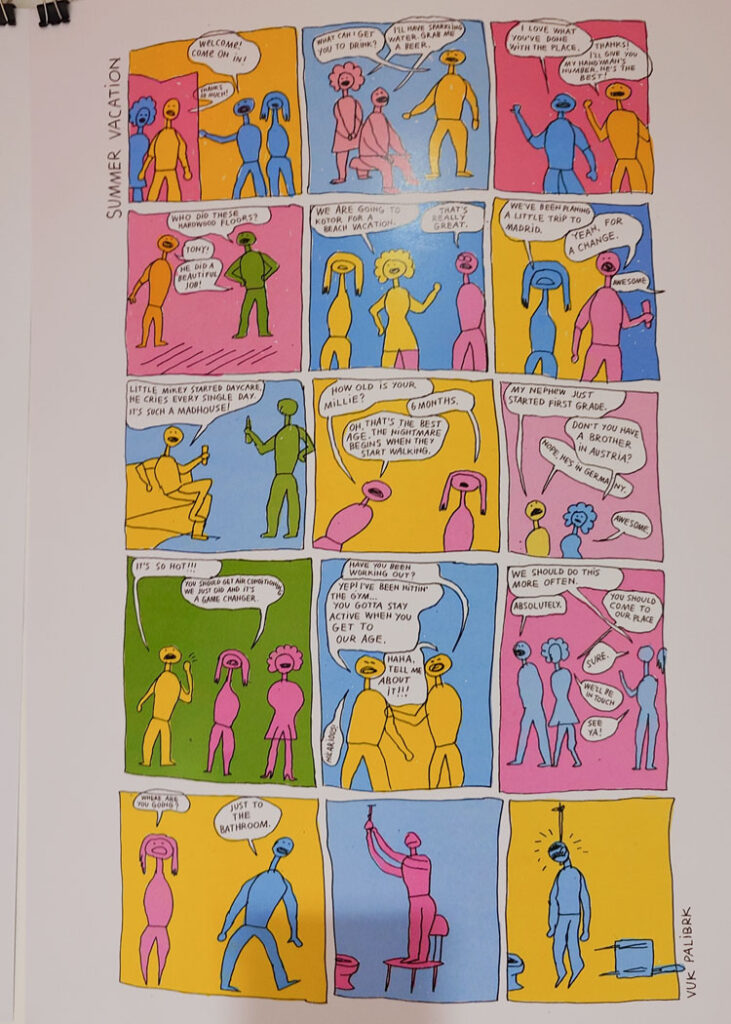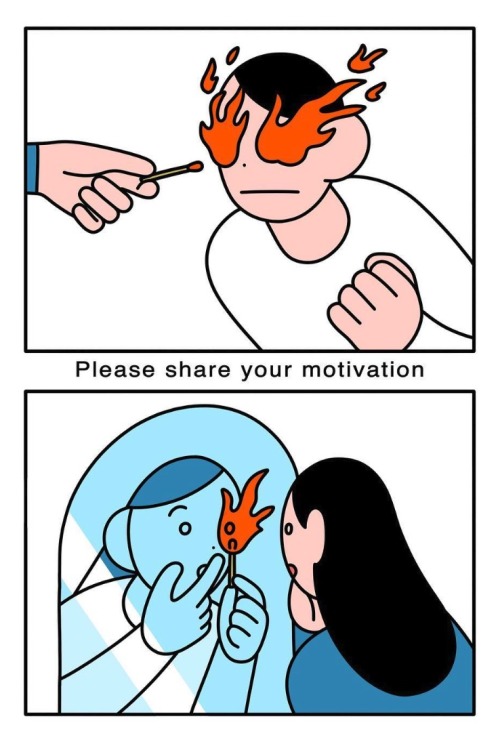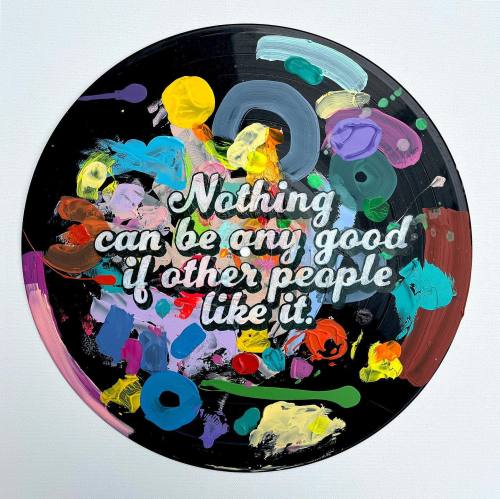Gah! I have a call in 24 minutes and I am still in my pants and need to wash! Gah!
Apologies, you didn’t need that image – but then again, none of us needed the sight of our elected representatives competing to see who could demonstrate the most nakedly-self-serving and venal behaviour while ostensibly pretending to give a fcuk about the deaths of thousands of people, and yet we all got that anyway, so frankly you can quit your whinging and be grateful for the links and the absence of my sub-Marina-Hyde ‘satire’ in the upfront.
[NB – non-English people, I promise it gets less obscenely-parochial in a few short paragraphs, don’t worry]
I am still Matt, this is still Web Curios, and you’re probably wondering how the everliving fcuk venture capital keeps getting away with this sh1t and if I’m honest I am wondering that too.

By Julia Maiuri
THE SECTION WHICH HAS GENUINELY FOND MEMORIES OF GETTING DRUNK IN THE VICE PUB BUT WHICH ALSO CONCEDES THAT ANY MEDIA BUSINESS THAT THINKS ‘BUY A PUB’ IS A VIABLE WAY TO INVEST SOME OF THAT VC CASH IS PERHAPS NOT DESTINED FOR SUCCESS AND LONGEVITY, PT.1:
- Laika13: Do you have kids? Great! I hope the fact that you’ve condemned at least one other person, possibly more, to THIS FCUKING EXPERIENCE is one that you’re comfortable with, and you can sleep at night! Anyway, if you do and if they are of a certain age then you will almost certainly have grappled with, or be feeling guilty about, the question of whether kids should have unfettered access to smartphones and social media, and What Exactly All This Screen Stuff Is Doing To Young Minds – very much something that’s front of mind and media in the UK after the murder of Brianna Ghey and the subsequent conviction of the two kids who killed her, and an issue that’s been front-and-centre in the UK press (the same UK press which is, oddly, seemingly unwilling to question the extent to which its…occasionally questionable coverage might have in some way contributed to the murder of a trans kid)…you don’t, obviously, need my opinion on this, and so I’m not going to give it to you, but I figured you might be interested in this project which is both ‘semi-interesting bit of social commentary/AI experimentation’ and ‘one of the weirder bits of digital promo for an insurance company I’ve ever seen’. Laika13 is a project which ‘imagines’ (though looking around, you don’t really have to imagine) what a 13 year old kid raised exclusively on a diet of social media and ONLINE LIFE might be like – and then creates a chatbot of said kid, which journalists and interested parties can request access to, so they can see what sort of a MONSTER results from this sort of ‘raised by digital wolves’ upbringing. “Laika is an AI teenager raised solely on social media. Her personality, ideals, and opinions are 100 % shaped by the content and climate of popular digital platforms. Through her, we can observe and understand the potential risks of consuming too much social media, without exposing real kids. Laika is used for mental health research and education. For ethical reasons, Laika isn’t available to everyone. However, researchers, educators, and journalists can request to chat with her. Laika gets her knowledge from social media and may therefore exhibit controversial or harmful opinions spread on the platforms. Länsförsäkringar and the parties involved distance themselves from Laika’s views and values.” This is SO ODD – the fact that they have bothered to make this but then limited access to it to journalists who, unless the media in Sweden works VERY differently, strike me as being unlikely to be hugely-interested in a rudimentary chatbot modeled on a stroppy teen, and I simply don’t understand how this promotes an insurance company (do they offer a policy that hedges against the possibility that your kid becomes a TikTok-addled shut-in? I am guessing they do not), and I don’t know what it’s trying to prove or demonstrate…Still, for MILLIONS OF JOURNALISTS who I know read Web Curios every week, why not take a look? If you can get past the incredibly-weird ‘it’s PR for an insurance company!’ angle you might be able to eke a commission out of this.
- Unganisha: A bit of a pivot now, and what I hope is a pleasing antidote to all of the general digital disquiet which runs through the rest of Curios – animals! Nature! The gentle sound of the wind caressing the savannah! Unganisha is, as far as I can tell (sorry, the site’s in German and hence I’m relying on Google translate and my cursory skimming of the copy) a WWF conservation initiative taking place across Kenya and Tanzania, and this site collects information and video from the various initiatives across both countries and their borders, and the website effectively exists as an overview of the project, its scope aims and achievements…ordinarily, if I’m honest, I tend to be left a little cold by this stuff – partly because I’m joyless, partly because it’s hard to get a true appreciation of the majesty of the African plain and the wildlife and the light and sense of space when you’re sitting in a small, slightly dark flat in a part of London so far North it’s practically-Scotland, but I really enjoyed this site, which is beautifully designed and really slickly-made, combining video, photos, 3d map data to tell the story of the conservation work in unusually-rich fashion.
- Smitten Stories: Occasionally I get emails from people which make this whole, pointless, pyrrhic endeavour almost worthwhile (note the ‘almost’) – so it was this week, when I opened my Special Curios Inbox and found a message from one Shivani Gorle, who wrote: “A little something to perhaps feature in Web Curios: we (a culture writer and coder couple) built an erotic story generator over the weekend where you can create custom kinky stories featuring you and your lover (or anyone!) Smitten is our attempt to see how AI can improve intimacy, aid personal expression and offer a no-judgment space for sexual fantasies.All you have to do is input your prompts on characters, setting and action, and you can be as explicit as you want to be.” HOW DO I LOVE THIS LET ME COUNT THE WAYS!!! Firstly, anything at the confluence of ‘slightly-shonky experimental digital stuff’ and ‘bongo’ is very much my vibe; secondly, there is something SO PLEASING about knowing that in some small way this newsletter has found THE PERFECT AUDIENCE whereby people tell me about stuff like this – THANKYOU! Anyway, I did as asked and gave this a go – in the spirit of enquiry, I gave it a…er…*variety* of different scenarios and combination of types of mucus membrane to smush together, and…you know what, it wasn’t bad! I mean, look, full disclosure, I personally can’t quite get beyond the fact that the words here are just probabilitysmushed by The Machine and as such it’s not likely to ever going to form part of my erotic life (ask me again in a few years when I’ve been single for a while and have forgotten what the touch of another human is like) (also, sincere apologies for introducing the concept of the authorial ‘erotic life’ to the Curios experience, never again I promise), but the filth it generates is…genuinely-filthy, and it is good at picking out the specific kinks and scenarios you specify, and, honestly, I LOVE THE FACT THAT THIS EXISTS! Please give it a try – if nothing else you can use it to create explicit fanfic featuring literally anyone you know doing anything you want them to, so why not give that a try and send your friends a bespoke bongo story ALL ABOUT THEM (please under no circumstances do this unless your friends are a significantly more forgiving bunch than I would be in those circumstances).
- Ergoquest: As the Vision Pro hype starts to stabilise slightly, I’m starting to see videos of people using them where they basically just sort of lie catatonically, supported by a mountain of pillows and cushions as they try and find an optimal position in which they can sit for two hours straight with a telly strapped to their face without creating significant lumbar problems for themselves. A combination of VR tech and the continued promise/threat of THE METAVERSE (it hasn’t gone away, you know) means that there’s definitely a market for the sort of computer setup that will make it comfortable for people to sit for hours with some not-insignificant hardware attached to them, which is where the frankly-bonkers offerings at Ergoquest come in – I don’t really want to describe these too much, but instead urge you to click right in and look at the photos (and the pricing!) and then take a moment to imagine a) how big your house would need to be to fit one of these fcuking things in it in the first place; b) exactly how your partner, whoever they might be, would react were you to suggest that you might want to invest in one of these for the study. These are partly marketed as a solution for people with severe back issues and the like, which is obviously a fine and reasonable market to serve, but I remain convinced that they sell the vast majority of these to middle-aged men who were influenced a bit too much by The Lawnmower Man 30 years ago.
- Practice Interview: Another week, another raft of ‘not going to exist in a year or so’ speculative AI-based startups, building a service layer on top of someone else’s tech stack and, presumably, hoping to make it rich or cash out before the bottom falls out of all these things entirely. This one is a nice use-case for the tech – Practice Interview, as you might expect, lets you, er, practice a job interview with an AI, chatting to it like you would AN ACTUAL PERSON and then being rated on your performance and responses to questions. I wouldn’t, obviously, suggest that you use this – it’s a desperate attempt to charge money for something you could literally hook up yourself for free with a tiny bit of effort – but it’s a decent example of a genuinely-useful usecase for this sort of thing (just feed the GPT app your job spec, then get it to ask you interview questions and grade your answers) and yet another example of simple-but-potentially-fun things you can do with this stuff beyond ‘making terrible images and unfunny copy’.
- Kin: We’re all going to get digital twins or assistants, aren’t we? Not soon, obviously, but it strikes me that there are a significant (and likely to grow) number of positive (oh, ok, ‘positive’) use-cases for the idea of having a digital representation of yourself which can be used for, I don’t know, the completion of mundane online tasks (‘task your digital twin with doing your tax return – it has the legal right!’, etc etc). Anyway, while we wait for that sort of mildly-disquieting future to manifest itself (hang on, have I just manifested something? IS THIS HOW IT WORKS?) we have ‘Kin’, a prototypical and mildly-unsettling (to me at least) product which effectively offers itself up as your AI emotional support coach – you talk to it, you tell it about your life, and it is ALWAYS THERE to offer you support and guidance and counsel (whether or not it makes sense to entrust any aspect of your life to the probabilistic burblings of a jumped-up Casio is as-yet uncertain). The big gimmick, per the site, is PRIVACY – Kin promises everything is local and it never stores your data, and that as such you should feel comfortable telling it EVERYTHING – the site is significantly less forthcoming on any useful, practical details like ‘how the fcuk does this work?’ and ‘what is it built and trained on?’, but, well, who needs to know stuff like that? This is still pre-alpha, but you can sign up to the waiting list if you so desire – interestingly, if you do so, it asks you what about the service appeals – the first two options are something like ‘never judges me’ and ‘always listens’, which is both heartbreaking and I think a neat encapsulation of the sorts of people who are going to see themselves exploited left, right and centre by companies attempting to sell them solutions to their perceived social problems. I know, by the way, that I am fcuking boring on this, but can I once again take a moment to tap the ‘HOW FCUKING WEIRD IS IT GOING TO BE WHEN EVERYONE IS ASKING A MYSTERIOUS DIGITAL COMPANION ON THEIR PHONE FOR ADVICE AND EVERYONE HAS A DIFFERENT ONE AND NOONE KNOWS WHICH ONE ANOTHER PERSON HAS OR WHAT THEIR MYSTERIOUS DIGITAL COMPANION IS TELLING THEM TO THINK OR DO? VERY FCUKING WEIRD INDEED!’ sign.
- Samurai: One of the great defining features of our age, I think, is the rise of the ‘hack’ – the shortcut, the ‘cheat’s way’, the ‘secret trick that noone’s telling you about that allows you to skip the queue/effort/entry requirements for X and will grant you access to the secret club full of the pretty and rich and successful that you’ve always known existed!’ – and Samurai is kind of an ur-expression of that. “LEARN MORE BY READING LESS!” screams the miserable tagline, and that’s the premise here – it’s an AI-powered summarisation tool which basically combines those ‘read it later’ apps with the sort of joyless, functional misery of the sort of services that existed in the 80s which offered to sell you summaries of the world’s best business books as two-page pamphlets that told you ‘ALL YOU NEED TO KNOW’. One the one hand, this is sort-of funny; on the other, a combination of the terrifying infodensity of the now and the even-more-terrifying infodensity of tomorrow, and the human race’s seeming wish to just sort of ‘phase out’ the written word by 2045, means I can see this sort of thing becoming pretty ubiquitous pretty soon. Anyway, given the fact that YOU are currently engaged in skim-reading a weekly 9,000 word newsletterblogtypething about ‘stuff on the internet’ I’m going to guess that you’re perhaps less bothered by reading and prolixity than Samurai’s target audience might be – otherwise, though, sign up for the waitlist and know that I think less of you.
- The Dirty Protest: When was the last time an online petition made a blind bit of difference to anything? OH THAT IS RIGHT IT NEVER HAS! Honestly, one of my biggest bugbears in campaigning is when people spend time, money and resources on collecting signatures online – THESE THINGS ARE NEVER BINDING! NOONE HAS DO DO ANYTHING, EVER, JUST BECAUSE SOME PEOPLE PUT THEIR NAMES ON A WEBSITE! Still, I shouldn’t be mean – this is a GOOD PROJECT and a GOOD CAUSE, and timely and zeitgeisty what with UK comedian Joe Lycett having recently done a TV show pointing out that the UK’s waterways are increasingly full of sh1t. Should you wish to protest about this, I would suggest first and foremost stopping paying your water bills – they’re not legally allowed to cut you off! – on the grounds that the companies are not in fact providing the services that we are paying for (I personally think you could make it annoying enough for them to leave you alone, but, equally, I am not a lawyer and you should probably not take my advice on this!), but you could also sign this online petition against the despoiling of the global water table which, in a CLEVER CREATIVE TWIST, will have every name on it physically printed out using ink that contains actual sewage. DO YOU SEE? DO YOU SEE WHAT THEY HAVE DONE?!?! Once it reaches 1m signatories it will be taken to the European Parliament – I, er, have my doubts that that is going to happen, but put your name down in the hope that you can contribute to a large roll of (hopefully-recycled) dried woodpulp can be roundly ignored by Brussels in a few months’ time.
- Giga: A small, palette-cleansing browsergame made for O2 in France – it’s basically ‘Tempest’, and it’s approximately as challenging as blinking, but it’s VERY FAST which makes it a fun distraction for about 5 minutes while you wait for the kettle to boil.
- Online Rulers: A big caveat to this – I HAVE NOT TRIED IT AND I HAVE NO IDEA IF IT IS ACCURATE. Still, I very much like the slightly-odd digital/analogue nature of this, which is a website designed to basically turn your phone into an accurate ruler for measuring and marking. NB – Web Curios accepts no responsibility for any death, injury or significant structural damage that results from using this.
- The TikTok Short Film Competition: Now in its third year, TikTok is once again running a contest for filmmakers on the platform – this year’s it’s opened up to North America too, so RIP the number of entries, but if you fancy competing against THE WORLD to see who’s the best at making short films (according to whoever’s judging this) then you might find this interesting. This all ends up with the winning entries (across directing, script and overall best short categories) going to Cannes (no, lol, the GOOD Cannes!), which is admittedly pretty cool.
- 84-24: Are you one of those people for whom Macintosh products were and have always been PART OF WHO YOU ARE, even when they were beige and uncool and confusing (‘what are these weird computers with the even weirder mouses and the terrible graphics, and WHY ARE THERE NO GAMES ON THEM?) and who has a tattoo of the logo and that sort of thing? GET ANOTHER FCUKING OBSESSION THEY ARE JUST MACHINES! Ahem. But, also, you will probably adore this genuinely-beautifully-made site which basically celebrates an old Apple and the process of restoring it. Such nice webwork, lovely scrolly animations and a real sense of passion for the kit and the project make this a charming little site. Made by one Michele Giorgi, who’s obviously very good at this stuff.
- A Year of Cartier: Ordinarily when I feature luxe websites in here – certainly in recent years, at least – it’s been to laugh at them, to point and prod and their odd metaversal ambitions and to question why exactly spending all of 80 seconds in a poorly-designed, shonkily-rendered representation of a CREATIVE ATELIER would be likely to induce me to drop five figures on a handbag. BUT! I confess to…actually quite liking this site by Cartier, which highlights a bunch of projects that the house undertook last year and which, honestly, is…really interesting. I say this as someone who is down to his last two pairs of trousers (the others have too many holes in them to be viable without arrest) and who last looked in the mirror on Tuesday and whose approach to fashion, design and style might best be described as ‘frightened and suspicious’, but there’s loads of genuinely quite cool insight into the design and manufacturing process over several dozen different areas of the brand’s work, and there’s something nice and gentle and…elegant about the design, and, unusually for these sorts of things, there’s actually quite a lot to explore, and at no point did it feel like I was about to be shaken down for a £600 keyring at any point. WELL DONE, LUXE WEBMONGS!
- Robin Rendle: Robin Rendle is a web designer and writer from the UK, who apparently now lives in San Francisco (I am not stalking him – it literally says this on the landing page of this site). This is his personal website, which is presented as a series of cards and I LOVE THIS AND I WANT MORE SITES BUILT ON THIS PRINCIPAL PLEASE. Oh, and seeing as we’re here, BONUS IMPRESSIVE PERSONAL WEBSITE!: this is a gorgeous little 3d environment by Mike Fernandez, where you can explore his career to date by wandering around a little mediaeval townscape (though be warned, I did get stuck on the well and have to reload).
- Inheritance: It’s been far too long since I’ve had cause to feature a good ‘interactive documentary website thing’, so I was thrilled to find this this week (and surprised to discover it wasn’t, for a change, made by NFB Canada, who for 10+ years have been the undisputed champions of this sort of medium) – obviously you’re free to approach Curios however you like, and I’d never be so gauche as to suggest what you should choose to click on, but can I make a special request that you take 10 minutes at check this out? It really is gorgeous – it’s a companion piece to a series of documentaries about the Lockerbie bombing of the 80s, and focuses on the memories left behind by Ken Dornstein’s brother David who was killed in the attack, and it uses old objects and memories and voice over and video and it is, honestly, really really beautiful.

THE SECTION WHICH HAS GENUINELY FOND MEMORIES OF GETTING DRUNK IN THE VICE PUB BUT WHICH ALSO CONCEDES THAT ANY MEDIA BUSINESS THAT THINKS ‘BUY A PUB’ IS A VIABLE WAY TO INVEST SOME OF THAT VC CASH IS PERHAPS NOT DESTINED FOR SUCCESS AND LONGEVITY, PT.2:
- The Dark Forest Anthology of the Internet: A caveat here – this is a physical book, which you have to order and pay for, and I have not yet done that and as such I have no idea if it is any good or not. BUT! I am on the mailing list for it for some reason (GDPR be damned!) and it features work by all sorts of people whose writing and thinking I have featured here over the years and who are all loosely sort-of affiliated with the wider “‘small/tiny/cosy/insert your own twee signifier here’ web” movement, and the description – “This is a book about how to survive on the internet. It’s about the cozy web, the dark web, the dark forest, the clear net, the dark net, and a new social world emerging around us. This is the Dark Forest Anthology of the Internet.” – really interested me. It features a selection of essays and thinking about the web and where it goes and what it is and what it was, and if you’re interested in the (admittedly quite w4nky) questions of ‘whither the web and the people on it in the mad uncertain days of AI and post-social media?’ then you might well think spending £30 on this limited edition tome might be worthwhile.
- Netflix En France: For those less linguistically-blessed than I am, that means ‘Netflix in France’ – you’re welcome! While it may be clear to everyone that we have come to an end of a specific era in media, specifically the end of the era of ‘free money’ (but sadly, I fear, not the end of the era of ‘genuinely terrible morons sitting at the top of these companies and making awful decisions’), noone appears to have told the people behind this excellent, lavish and sort of magically-pointless bit of webwork for Netflix France, which basically seems to exist as a sop to the French government and tourist board for letting the company film shows within their borders. This is, basically, a bunch of not-particularly-in-depth ‘tourism guide’-type content, all themed around various French Netflix shows that have been shot in France, featuring GORGEOUS video and basically showing all these gorgeous locations off to their very best – still, if you’ve been really getting into, I don’t know, “Lupin X Marie Antoinette” (I don’t have Netflix and know nothing about any of its French shows, can you tell?) and want to plan a journey based on ICONIC SCENES from the programme then, well, ENJOY!
- Password Basket: Shamelessly lifted from last week’s B3ta, this is a genuinely brilliant little game which helps you generate a new, secure password each time you need one, and which is so good it ought to be bought wholesale by AN Other online security business looking for some easy promo. Look, I know that there is at least one person reading this who works in a skullfcukingly-tedious branch of comms and who has been waiting YEARS for me to feature something in Curios that’s appropriate for creative thievery – NOW IS YOUR MOMENT!
- Oops Busted: IMPORTANT CAVEAT TO THIS LINK: I am posting this here because I am reasonably-confident that noone reading this is actually going to use it. Please do not use it. ANYWAY, now we’ve got that out of the way, welcome to what I am 100% convinced is the most morally-bankrupt link of the week – I’m going to hand over the description here to the devs, from a Reddit post: “OopsBusted is a unique digital platform designed for those curious or concerned about their partner’s activity on dating apps. In an age where online dating is ubiquitous and the lines of fidelity can sometimes blur, we provide a discreet and efficient way to uncover the truth. How does it work? Simple! You provide the name and location of the person you’re curious about, and our platform does a sweep of popular dating apps to see if they have a profile. Think of it as a helpful tool to either quell your fears or confirm your suspicions—all done discreetly and respectfully. But OopsBusted isn’t just a tool; it’s a community. We’re here to discuss everything from relationship advice and digital dating trends to ethical considerations when using technology in our personal lives.” Take a moment to consider that, and think about the implications – a service that lets you provide a subject’s name AND PHOTOGRAPH, and which uses that information to stalk them across dating sites…you can see how that’s perhaps not ENTIRELY safe? I am genuinely astonished that this exists – the only silver lining is that I have strong suspicions that the ‘AI tech’ under the hood here is largely rubbish and won’t work, given I imagine all the dating apps have reasonable guardrails to prevent exactly this sort of thing from working, but, honestly, this is literally a ‘want to stalk anyone in the world and harass them with ‘romantic’ proposals? GREAT!’ service, and that doesn’t really feel ok. In the unlikely event that you happen to work for any of the major dating apps can you please reassure me that this is just a scam to con stalkers and potential-rapists out of cash? Thanks.
- Don’t Look Down: A subReddit dedicated to sharing videos and photos of VERY HIGH PLACES. I am not particularly afraid of heights – per Sir Terry, it’s the grounds that kill you – but when I found this the other day there was a video on the top of the page that featured two people jumping off a waterfall a la Butch Cassidy and they jumped and the angle panned down…and down…and down…and they kept falling, and basically my stomach ended up somewhere underneath Bounds Green tube. It’s ALL like that, so, well, enjoy!
- 38 North: Are YOU fascinated by North Korea? Are YOU anxious to keep up with Kuddly Kim and his Krazy Kapers? Well you may well enjoy 38 North, in that case, a site seemingly dedicated to ALL THINGS North Korean (from a ‘what are they up to?’ point of view rather than a ‘wow, look at the kooky dictatorship!’ perspective) and which might be useful if for whatever reason you need to have a vague idea about how long it’s going to be til the world’s most famously-mad regime has another conniption.
- Flirt WIth Emma: Earlier this week this app was called ‘Flirt with Los’ – now it’s called ‘Flirt with Emma’ – I think, though, the premise is the same, a sort of art-game-app-thing, which plays on the general concept of the online dating app by giving users the opportunity to date ‘Los’ (and now ‘Emma’), which basically amounts to a few limited interactions each day where you can send messages to a static image of this stranger…and that’s sort-of it, except there’s a real person behind this (maybe even two) as you can read in this article explaining a bit about the project, and I think it might be a bit more interesting and involved than it otherwise looks.
- My Boyfriend: Would YOU like to contribute to the next edition of a magazine featuring writing from new and emergent writers? GREAT! My Boyfriend is a seemingly-ongoing project which will in each edition solicit submissions on a single theme or topic – next up is “My Boyfriend Is A Virgin. Send us short stories and poems which interpret the theme of “virginity” either in the literal or abstract. We especially appreciate absurd, voicey, and experimental works. For this issue, we are not looking for pieces that explicitly reference the mag’s name or that contain a boyfriend character. 1500 word limit. Deadline April 15.” Sound interesting? GO!
- Join The Mars Living Experiment: OK, before you get too excited I feel compelled to tell you that this opportunity is only open to US nationals what with it being a NASA initiative – still, for the two of you reading this on the other side of the Atlantic WHAT AN OPPORTUNITY THIS IS! “Crew Health and Performance Exploration Analog (CHAPEA) is a series of analog missions that will simulate year-long stays on the surface of Mars. Each mission will consist of four crew members living in Mars Dune Alpha, an isolated 1,700 square foot habitat. During the mission, the crew will conduct simulated spacewalks and provide data on a variety of factors, which may include physical and behavioral health and performance” – and they are now accepting applications! Look, you may have things like ‘a family’ or ‘commitments’, but the next programme doesn’t start until next year so you’ve loads of time before that to divest yourself of any and all responsibilities so you can go and live in a simulated hostile environment for a year, drinking distillate of your own p1ss and eating powdered icecream (probably).
- TrudyTube: I’m always something of a sucker for personal quantification projects, particularly when combined with nice design and visualisation – this is a site in which someone called (I presume) Trudy maps all the songs she listens to, when she listens to them and the context in which she’s so doing, and I LOVE IT IT IS WONDERFUL, like a sort of emotional audio relief map of the day – you can hover over the tracks to hear them, click them to be taken to the whole song, explore the changing patterns over different days…honestly, the only way this could possibly be improved is if there were a geo layer over the top so you could see whether / how geography affects style/vibe of song, but I appreciate that there are very good privacy and safety reasons for ignoring this request entirely. Anyway, this is GREAT and I would really like someone at Spotify to read this and request it as a product feature please (LUKE THIS IS FOR YOU).
- The 2024 Webring: This feels like it will be a link that will neatly divide the readership between THE OLD, for whom the concept of a webring is familiar and comforting and oddly-Proustian, and THE YOUNG, for whom it will ins…actually, no, hang on, there is no way in hell that ANYONE reading this fcuking thing is under 30, so let’s assume that we all know what a ‘webring’ is and move on. “This website contains links to 13 single serving sites, connected as a webring. The websites take their starting points in Wikipedia articles linking to the Artificial intelligence page. Next to each link, there is a link to a promotional or explanatory TikTok. The SSS:s were made in February 2024 by the first year students in the Interactive design course at the Visual Communication program at Beckmans Collage of Design in Stockholm, Sweden. The course is supervised by senior lecturer Peter Ström.” SO MANY FUN LITTLE WEBSITES! I honestly think there’s something rather lovely – and due a sort-of reappraisal or comeback – about the idea of the webring, a small, tightly-curated network of interest-connected people or pages, free of algorithmic mediation, a sort of digital desire path through websites…does this make sense or am I just w4nking on? It’s the latter, isn’t it?
- The Best Videos Of The Year: Or at least, the ones Vimeo selected as the best videos of last year. A couple of these I had seen before (a couple were featured in Curios, I AM SUCH A GOOD CURATOR LOVE ME ACKNOWLEDGE MY SUPREMACY), but most were new to me, and there’s a nice mixture of animation, documentary, music video and short film to explore for the visophiles (is that a term? It ought to be) among you.
- Alps Roads: After last week’s links to that twisty roads website, here we are with yet ANOTHER link for the mesh-driving-glove-owners (I may mock you, but also I spoil you – feel the push/pull of the abusive relationship!) – DO YOU LIKE ROADS? I am going to suggest that however deep your love for tarmacadam runs it runs nowhere near as deep as that felt by the administrator and owner of this singular site, dedicated to chronicling all the roads that this person has ever visited (I am not, I don’t think, exaggerating). You want photos of minor trunk roads in Nevada? GREAT! Want some inexplicably-blurry photos of some road signs in Saudi? Er, why? BUT GREAT, HERE YOU ARE! Anyway, I love the fact that this person really enjoys roads and wants to celebrate them via the medium of an increasingly-sprawling single-focus web presence, so well done, anonymous road enthusiast,.
- Clove Garden Recipes: One of the great complaints of the modern age – no, not that one. Or that one – is the weird effect SEO has had on online recipes and the way it’s led to food blogs being cluttered messes of personal writing when all the hungry, lazy chef wants is THE FCUKING RECIPE (but, equally, if you employ one of those ‘just give me the recipe’ Chrome extensions then you’re the monster – look, I don’t make the rules here, that’s just how we’ve decided things work). Clove Garden is a VERY old website which has seemingly been around since…2004, I think? Anyway, I think it spun out of a general sort of health/wellness interest (I am a bit scared to click on the ‘philosophy’ section in case it turns out to be a haven of weird fashiness tbqhwy) but the main draw here is the ‘Recipes’ section which features over 1000 different dishes and…THEY ARE JUST RECIPES! No anecdotes, no chat, just ingredients and method. It’s obviously important to caveat this in a few ways – firstly I have no idea if any of these are any good; secondly, it’s an American site which means that all the recipes in question use their preposterous measurement conventions (‘CUPS’ IS NOT A PROPER MEASUREMENT FFS); thirdly, it’s an American site which means that I can’t promise that half the recipes won’t be ‘a cup-a-soup and a block of velveeta’. Still, er, ENJOY!
- The Google Blobs: Back in the day I remember feeling a genuine sense of…minor shame? Christ, how pathetic…but, anyway, yes, minor shame at how rubbish the Google emoji on my crappy Android phone were compared to the LOVELY AND SHINY Applemoji on other people’s iPhones. I’ve since come to terms with my own pathetic device-based status anxiety, and with the Google Blob emoji style, and I got a proper small nostalgiapang when I found this site, which collects the original designs and animations and makes them available for use in Discord. BRING BACK THE BLOBS, basically.
- Matchonix: A fun little ‘match three shapes’ game with a couple of nice twists and a semi-realtime angle that makes individual matches short and snappy rather than an infinite timesink.
- Flip: Another tiny game made in V Buckenham’s forthcoming ‘Downpour’ tiny game engine, this is an excellent example of the sort of small, silly, pointless things that I am excited to see people making with the kit. Can you get 10 ‘heads’ in a row when flipping a coin? CAN YOU??? This is obviously very silly and pointless, but it’s also annoyingly really fcuking compelling – it’s also a nice illustration of the simple way in which Downpour will let you combine elements, and I am genuinely quite curious to see gets made.
- Squeezy: A word game! I know, I know, but this is quite a nice variant on a theme – there are five words, and five letters; each letter can be inserted into one of the existing words to create a new word – but which letter, into which word, and where? Not particularly difficult, but a pleasing way of starting the day while you chase The Fear away.
- Borg Remastered: Finally this week, another one of those bits of webwork that makes me slightly staggered at what is possible now vs what was possible even a decade ago – and a link which I think it’s statistically probable will make at least one of you ecstatically happy. Do YOU like Star Trek? Do YOU wish that you could experience what is effectively a full-length interactive film featuring AN ACTUAL PROPER STAR TREK ACTOR and two hours of all-new, TV quality Star Trek FMV action? Do these words mean anything to you (because, honestly, they mean the square root of fcuk all to me)? “In the midst of a Borg invasion ten years after the Battle of Wolf 359, Starfleet Cadet Qaylan Furlong is given an opportunity by Q (John de Lancie) to go back in time and prevent his father’s death in the historic battle.” Do they make you think “OH GOD THE BORG, THE GREATEST OF ALL THE STAR TREK VILLAINS!”? If the answer to any or all of these questions is ‘yes’ then welcome to the best link of the year so far – this is a full, playable, in-browser port of a 1996 videogame, from the era in which people thought ‘interactive films’ were the future of entertainment, and you can experience it all through what I imagine is some pretty-impressive in-browser wrangling, with a really slick and very Star Trek-y interface…look, I have to confess here that the meeting point of ‘Star Trek’ and ‘Full-Motion videogame that is basically an interactive TV show’ is a place I have literally no personal interest in whatsoever, and as such I only gave this 15m of my life, but it’s quite an incredible bit of webwork and deserves a click even if you would rather apply papercuts to your eyeballs and then rinse them in lemonjuice than admit to watching a second of Trek.

By Dadu Shin
THE CIRCUS OF TUMBLRS!
- Retro Lesbians: You don’t need me to explain this to you, do you? Totally SFW, at least from what I’ve seen.
THE TROUGH OF (INSTA) FEEDS!
- The Wonder of Soil: I had to do some proofing this week for an Italian academic’s newly-written paper about soil health (summary: wow, that was a whole new thing that we’ve managed to make a mess of which I had no idea about but which now I will add to my list of ‘vaguely disquieting things I know about the planet!), and I discovered this Insta feed which is dedicated to promoting, er, soil health, and look, it’s not exactly thrilling, but I thought it was important and so, er, here it is.
- Piedras Tirar: A Spanish-language Insta feed which seemingly exists solely to collate and share videos of people lobbing big stones off things. As far as I can tell this is entirely-benign rather than some sort of semi-rural terrorism, and as such I feel reasonably comfortable linking to this – they accept submissions from around the world, so if YOU want a video of you lobbing a rock off the side of a cliff to be shared with a global community of 1.1m people then, er, here!
LONG THINGS WHICH ARE LONG!
- Good Writers Are Perverts: We kick off with an essay whose presentation I appreciate might get on your tits a bit – SORRY! – but which I humbly suggest is worth persisting with because I adored the argument it makes and, personally, feel it quite strongly (just turn off your volume when you’re reading it, because the sound effects are annoying). The central theme of this essay is – per the title – that all writing worth reading comes from a place of ‘perversion’ or ‘fetish’ – not sexual, not erotic, not even physical (although it can and often is born of all of these different sorts of ‘perversion’), but more speaking of a peculiar and perhaps-ostensibly unhealthy relationship with a topic or subject or idea or THING, and that without that ‘perversion’, that unhealthy fascination and that desire/need/compulsion to get *inside* the thing, you don’t get the same quality of writing. I don’t know about you – I don’t! I promise! – but this rings true when I think of the authors I like best on any given subject or theme, any style, and realise I like them because of their perversions. Some authors are just LANGUAGE perverts, some are style perverts (Martin Amis, to use but one example, was very clearly a sentence pervert, amongst other things), I am (and this feels very weird to write down and articulate, but I think this is a safe space and it’s probably not a secret by now) a web pervert…EMBRACE YOUR PERVERSION AND REVEL IN IT! ROLL AROUND IN ITS FILTH! Ahem. Anyway, I loved this and I think it’s brilliant, and I think lots of you will too. BONUS PERVERSION! I think this widely-linked essay, about sex and physicality and body horror and the links between all of them, is an excellent example of this – the authorial perversion here isn’t the sex so much as the willingness to get into the viscera, for example…you’ll get what I mean, I think, hopefully.
- The State of the Culture: One of the most-shared essays of the past week (excluding those about book reviews, divorce or being scammed out of $50k, none of which we are doing in here because, honestly, life is TOO SHORT) was this one, by Ted Gioia, on where HE thinks we are as a culture. Now I’ve been reading Ted’s newsletter since it started a few years back, and have featured his writing a few times here, and I broadly like it, but I have felt he’s perhaps been getting a BIT self-satisfied at times, and this piece continues that trend – that said, it also feels RIGHT in an unusually-accurate way, and also like it might be a helpful way of framing certain questions and considerations about The Culture and The Content, and as such I’ll forgive the slightly-annoying fogeyish tone of the second half (lol, like Ted gives a fcuk). The central premise here – and, honestly, you can get away with only taking this one lesson from the piece – is that our current era prioritises ‘distractions’ over ‘entertainments’, and this distinction is a meaningful one when considering the cultural marketplace and all the things that flow from it. I mean, it’s hard not to argue – there are many other things I could have linked to as ‘illustrative examples’, but I thought this Guardian article, about the surprising market for ‘games’ that are literally just ‘something to do with your eyes and hands while you wait for your cells to start doing weird things and the cancer to come’, worked best.
- Google Gemini Advanced: I don’t mean to do PR for Google, but it’s worth mentioning that you can get a two-month free trial of its ‘Gemini Advanced’ LLM which imho is very much worth having a play with – its ability to parse and fillet REALLY LONG AND BORING DOCUMENTS is genuinely transformative, and you can force it to provide you with on-page examples from a PDF to limit its propensity towards hallucination, which starts to feel like a genuinely-useful thing.
- Why The JobsPocalypse Won’t Happen: I concede that I have spent a lot of time over the past year or so being a miserable fcuking Cassandra about AI and how it is going to fcuk SO MANY OF US when it comes to our ability to earn a crust from our pointless whitecollar skills in the near future – so here’s an alternative perspective, from someone who thinks I am a moron who worries too much. This piece, by David Autor, effectively predicts that AI will, rather than eliminating huge swathes of white collar buswork and replacing them with….nothing!, the tech will instead usher in a better, freeer era characterised by human expertise and intuition guiding machine labour in perfect, symbiotic harmony! To quote the author, “The unique opportunity that AI offers humanity is to push back against the process started by computerization — to extend the relevance, reach and value of human expertise for a larger set of workers. Because artificial intelligence can weave information and rules with acquired experience to support decision-making, it can enable a larger set of workers equipped with necessary foundational training to perform higher-stakes decision-making tasks currently arrogated to elite experts, such as doctors, lawyers, software engineers and college professors. In essence, AI — used well — can assist with restoring the middle-skill, middle-class heart of the U.S. labor market that has been hollowed out by automation and globalization.” Look, you’ll have to read the whole thing and make up your own mind, but I will respectfully say that this is another one of those bullsh1t utopian pieces written by someone who I am reasonably-convinced doesn’t have the faintest fcuking idea how mechanical and non-thinky a vast swathe of the current Western job market is, or indeed how many spaces are going to be available in this glorious future he imagines for the ‘insight-powered decision makers’ he envisages. Because I guarantee you the answer isn’t ‘billions’. As a brief, real-world counter to this, I had a meeting this week in which the client, someone working for the massive, multinational FMCG giant that isn’t P&G, basically said ‘so what we need is a tech stack that will do 70% of what we currently employ Publicis for, but for 10% of the cost’, just in case you want a more practical and grounded example of where this is going in the short-to-medium term.
- Why Sora Still Doesn’t Understand Anything: AI curmudgeon Gary Marcus gives a good, short explanation of why anyone claiming that last week’s carefully-curated tech demos of OpenAI’s new text-to-video product Sora show that The Machine is starting to gain anything resembling a meaningful ‘theory of the world’ is a fcuking idiot – this is useful from the perspective of grounding the debate slightly, but it doesn’t change the fact that 3s video clips for small online ads are not going to be created by people any more in a year.
- Making an App With GPT: Matt Webb – whose AI Poem Clock is NEARLY FUNDED with a few days to go, so well done Matt – writes a useful little blog about how he made a totally pointless mobile app, entirely coded by GPT; now it’s important to note that Matt obviously does know a BIT about coding and as such it’s relatively simple for him to see where the errors are, etc, but this is generally a really good note explaining how you really can use these things to bring your ideas to life (with a bit of effort).
- Why the Games Industry is so Fcuked: An interesting overview of the current malaise affecting the videogames industry which, despite the fact that more people are playing the things than at any point in their history, is seeing studios shrinking or shutting down at a rapid rate as yet another sector discovers that, maybe, perhaps, the people at the top are not in fact business visionaries but are instead greedy morons like the rest of us. There’s a lot in here, and it’s quite ‘inside baseball’, but I think there are probably one or two potentially-useful parallels to be drawn with other industries that are also going through somewhat parlous times.
- The Death of Independent Digital Publishing: To be honest, given this week’s media news I could probably have cut the ‘independent’ term from the headline – still, this is a really interesting piece (if an incredibly frustrating and slightly-depressing one) on how a combination of AI, scraping and outright lying means a familiar collection of URLs dominate Google rankings for basically everything, regardless of the query in question. The article’s written by a couple who’ve been doing the content marketing/SEO game for a while and who have increasingly realised that the game might be up, because it’s simply too easy for site’s with existing PageRank supremacy to spin up any old sh1t in seconds and immediately dominate the seach rankings for basically anything you fancy. I appreciate that this is a slightly-tangential point, but with the entirety of the VICE back catalogue being killed and sites shutting down and going zombie left, right and centre, it does feel rather like we’re not just approaching a future in which we’re drowning in AI content slurry but that we’re actively encouraging it. WHY DO WE HATE WORDS SO MUCH?
- Why Microtribes Are Ruining Company Growth Plans: To be clear: I don’t agree with this headline, or this article, and think it’s largely b0llocks. However, it made me laugh for two reasons – firstly, in 2005 (I think) Channel4 in the UK commissioned a big bit of research to accompany the launch of series (I think) 3 of Skins which looked at the growing MICROTRIBES in UK youth subculture, which I remember reading with interest and using as a hook for all sorts of spurious ‘cultural PR’ work – LOL THERE IS NOTHING NEW UNDER THE SUN!; and secondly, I also read this article this week which confidently suggests that in fact TRUE teen subcultures are DEAD and that actually all the different tribes and microaesthetics that the web gets obsessed by are in fact too shallow to be meaningful, and which personally I thought was a slightly more helpful angle from which to look at this.
- Right Wing Italians and Fantasy Literature: I rather enjoyed this Economist piece, not least because it told me something I’d never really clocked about the Italian right before – although, now I think of it, I did clock the ‘Atreyu’ conference name last year and raised an eyebrow; anyway, this is an enjoyable article about the reasons why there’s a slightly-unexpected affinity between 20thC fantasy fiction and Giorgia Meloni and her arm-twitching chums.
- 764: Given its demise, possibly the last new Vice dot com url I am ever going to feature in Curios – RIP lads, you basically started losing it when you left Canada but I will always remember the borrowed air of cool I felt in 2000 or so thanks to being familiar with your output – but it feels like quite a VICE story, combining ‘really unpleasant sex stuff’ with ‘crime’ and ‘messed up kids’ and ‘the internet’. The piece is a really quite impressive piece of longrunning investigative journalism which, over the past year or so, has involved infiltrating and investigating online spaces connected to a group called ‘764’, which, long story short, is comprised of people who get off on making other people do humiliating or harmful things to themselves on camera as a power fetish thing. OBVIOUSLY this is all really horrible and shocking and gross – equally, though, I think this is excellent reporting of an obviously-horrific topic, which goes out of its way at all times not to sensationalise or exaggerate or pretend this is anything other than an INCREDIBLY NICHE phenomenon. Basically, parents, DON’T READ THIS AND GET FREAKED OUT. But, equally, probably a good idea not to let your 13 year old have unlimited Discord access, eh? BONUS ‘BAD INTERNET’ CONTENT: this is an interesting NYT investigation into ‘disgusting men seeking out people posting frankly ill-advised photos of their young kids on Instagram’, which, again, is horrible and creepy and troubling, but which to which, once again, my immediate reaction was ‘much as I hate them I don’t think that it’s the platforms that are the problem here’.
- JD x MBS: I don’t quite know what I was expecting to read in a Vanity Fair article extolling Johnny Depp’s growing ‘bromance’ with definitely-not-murderous head fe the House of Saud MBS – maybe I shouldn’t have been surprised that a magazine whose raison d’etre is seemingly to tongue the sphincters of the rich and famous to a highly-reflective sheen applied a less-than-critical eye towards the relationship between a fading Hollywood star and a man who’s plainly stated that he wants to make the country he runs a ‘cultural superpower’, but my jaw did slightly drop at various points throughout this piece as it variously glosses over some of Depp’s travails and, more seriously, the whole ‘potentially murderous and not-undespotic regime’ thing. I mean, look, this para is a decent example: “Depp, who did not recognize himself in the tabloid coverage of the Heard trial, was beginning to question the Western narrative about Saudi Arabia. The crown prince said the world had unfairly tarnished him as a bloodthirsty dictator in the vein of Saddam Hussein. This was Saudi Arabia’s greatest moment, he told Depp, a major transformation perceptible even on a monthly basis, if people would only bother to visit.” Only a cynic would ask “so, troubled and increasingly-unbankable and famously-financially-incontinent filmstar, what first attracted you to become the convenient Hollywood figleaf for a man whose wealth is simply immeasurable?” – but thankfully Bradley Hope at Vanity Fair is no such cynic, and the question goes unaddressed.
- Can Saudi Buy Soccer?: Think of this as a companion article to the last one (and don’t be put off by the headline, it’s written by the reliably-excellent Oli Franklin-Wright rather than a know-nothing yank (I jest, I jest, please let me have my lazy national stereotypes they are all I have left) and is a suitably-wide-eyed and slightly-baffled look at the ostensibly-insane project to make a desert nation one of the world’s footballing capitals. This is in parts very funny, but it’s a less-miserably-cynical piece than I would have written and much better for it (there are (multiple) reasons why I am not a journalist).
- Vialli: Another piece of writing about football, and one which is in Italian – I think Google Translate will do a decent job on this, though, so feel free to dive in regardless. This is a BEAUTIFUL piece of writing remembering Gianluca Vialli and his career, and his impact on the city of Genoa where he’s remembered as a native son for his years at Sampdoria, and if youre either a football lover, or someone who remembers the Football Italia years on Channel 4, or simply if you enjoy a beautifully-written tribute, this is a treat. Grazie Irene!
- Ahab’s Leg: Unexpectedly one of my favourite pieces of the week, this is a WONDERFUL bit of obsessional research which is far more interesting than it ought to be, particularly for someone who’s never read Moby Dick and, if I’m honest, is unlikely ever to bother (I think it’s important to know and acknowledge one’s limits) – you may be aware that Captain Ahab is one-legged, having lost a limb to the titular white whale, but did you know that at no point in the text is it specified which of his legs he is missing? Adam Mellion knew, and this knowledge vexed him – and so he decided to work it out. This is a two-part essay (the second is here), and while I appreciate that several thousand words about searching for clues as to whether a fictional character was missing their left or right leg doesn’t SOUND compelling, well, it is great and funny and interesting, and will leave you feeling like you DEFINITELY know enough about Moby Dick to avoid ever having to read the whole thing.
- Stop Letting Famouses Write Children’s Books: This is written by Phil Womack, who writes books for kids and who is, perhaps not unjustifiably, a bit annoyed about the fact that approximately 96% of shelfspace at attention (and subsequent sales) in the kids books market is devoted to the output of celebrity authors (WALLIAMS YOU CNUT) and how that doesn’t necessarily seem fair or ok. I am including this mainly because it made me laugh a lot, partly because it is true that the market is preposterously-skewed in favour of the already rich and famous who, and partly because it obviously really annoyed David Baddiel, who bothered to respond to it by pointing out not-at-all-pettily that Womack is himself married to some sort of mittelEuropean princess and is therefore himself not exactly a stranger to privilege. Deliciously petty (although you’d think Dave, with ALL OF HIS SMARTS, might have been able to see that that’s not really a meaningful equivalence), and very fun.
- The Rise of the Woman Butcher: I adored this piece, all about how the traditionally-masculine world of butchery is slowly, in a few places, beginning to open up to women, and how the trade works, and about the weird poetry of cutting meat (I know that that sounds weird but some of you will understand – er, anyone?) and there is some beautiful writing here about blood and meat and death but also about society and gender and history and, honestly, this is superb.
- Shifting Baselines: About climate change and alzheimer’s and death and forgetting and accepting new normalities that relate to the old ones in ways we didn’t ask for and don’t necessarily want or like. I found this almost unbearable in places, but that’s about me rather than the quality of the writing, which is beautiful.
- I’m A Fan: Finally in this week’s longreads, a review which is more than a review and which still works if you’ve not read the work it’s addressing. I read and enjoyed “I’m A Fan” by Sheena Patel – this is a piece of writing about the novel by Zarina Muhammad at White Pube, who didn’t like it and who writes about it in this piece which is sort of a review and sort of a meditation about the things the book raises but, mainly, a fcuking GREAT piece of writing about race and femininity and anger and England and the limits of SPEAKING ONE’S TRUTH and I thought this was brilliant and the best thing I have read all week.

AND NOW, MOVING PICTURES AND SOUNDS!:


































